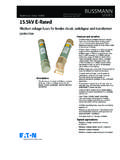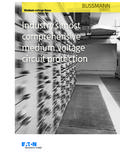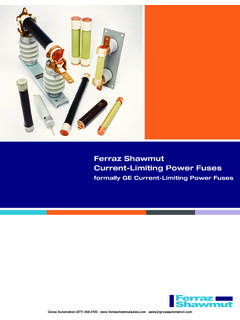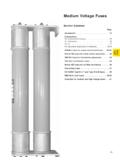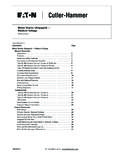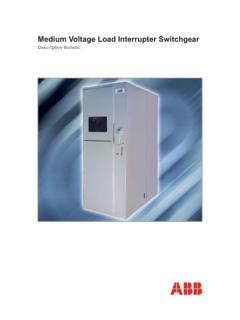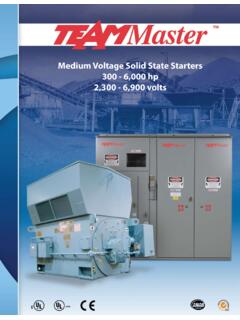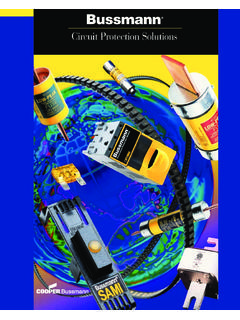Transcription of Current Limiting Fuses - Eaton
1 Volume 14 Fuses CA08100016E August 2011 Limiting FusesEaton Current Limiting Fuses OverviewProduct Description .. Selection fuse Selection ..V14-T3-5 Current Limiting Applications .. Applications .. , HLE, LHLE, AHLE, BHLE, HCL and BHCL Type Fuses CLE, HLE, LHLE, AHLE, BHLE, HCL and BHCL Type Fuses .. and NCLPT Type Fuses CLPT and NCLPT Type Fuses .. , BCLS, CLS, HCLS and NCLS Type Fuses ACLS, BCLS, CLS, HCLS and NCLS Type Fuses .. Type Fuses CLT Type Fuses .. , CXI and CXN Type Fuses CX, CXI and CXN Type Fuses .. , MDSL and NPL Type Low Voltage Current LimitersDSL, MDSL and NPL Type Low Voltage Current Limiters ..V14-T3-76V14-T3-2 Volume 14 Fuses CA08100016E August 2011 Limiting FusesProduct OverviewCurrent Limiting Fuses ContentsDescriptionPageConstruction.
2 V14-T3-3 Interruption and Operation ..V14-T3-3 Application ..V14-T3-4 Mountings ..V14-T3-4 Product DescriptionIntroductionEaton s medium voltage Fuses provide diverse characteristics that allow them to be used in any application within their practical range. This difference is due to the offering of both expulsion and Current - Limiting Fuses . Expulsion and Current - Limiting Fuses employ different interrupting techniques that cause the criteria with which they are employed to differ. This requires that a different set of questions should be answered when applying expulsion and Current - Limiting Fuses . For this reason, and to avoid confusion, this application data applies only to Current - Limiting Fuses . For information on the application of expulsion Fuses see Eaton s Expulsion fuse Product TypesCurrent ANSI/IEEE fuse standards define three types of Current - Limiting Fuses : back-up Fuses , general-purpose Fuses and full-range Fuses .
3 It is important for the user to have an understanding of these definitions to ensure proper application of the backup Current - Limiting fuse is able to safely interrupt all values of fault Current from the rated minimum interrupting Current up to the rated maximum interrupting Current of the fuse . Although only backup Current Limiting Fuses make a specific reference to a rated minimum interrupting Current , general-purpose and full-range define a rated minimum interrupting Current in different terms. The rated minimum interrupting Current of a general-purpose fuse is the Current that causes the fuse to operate in one hour, and the rated minimum interrupting Current of a full-range fuse is the minimum value of Current that will melt the fusible element(s) under specified , Eaton s backup Current - Limiting Fuses are the R-rated range, which have a rated minimum interrupting Current equivalent to the 100 second Current on the minimum melting time- Current curve.
4 This point is not necessarily the limit of low fault performance, merely the required limit of low fault performance, in line with the normal application practices for this type of fuse , which is used for high fault protection of medium voltage motor starters in conjunction with relays and overload s R-rated backup Fuses may be thermally damaged or may not operate correctly if subjected to overload currents greater than those shown on the safe overload curves and the rated minimum interrupting Current for long general-purpose Current - Limiting fuse is able to safely interrupt all values of fault Current from the Current that causes the fuse to operate in one hour or more up to the rated maximum Interrupting Current of the one hour melting time is with the fuse in a conventional mount, and in a 25 C ambient.
5 Other mountings or ambient conditions may cause the fuse to melt earlier, but this does not alter this rated minimum interrupting Current . Eaton s general purpose Current - Limiting Fuses are used to protect circuits feeding transformers and feeders, where there is downstream protection that will operate before the medium voltage general-purpose fuse is affected by a long term overload. See application notes on feeder and transformer protection for details. Eaton s E-rated general-purpose Fuses may be thermally damaged or may not operate correctly if subjected to overload currents greater than those shown on the safe overload curves and the indicated one hour interrupting Current for long full-range Current - Limiting fuse is able to safely interrupt all values of fault from the minimum value of Current that will melt the fusible element up to the rated maximum interrupting Current under specified s full range Current - Limiting Fuses are used to protect circuits feeding transformers and feeders.
6 Where there may not be any effective downstream 14 Fuses CA08100016E August 2011 Limiting FusesProduct OverviewConstructionCurrent- Limiting Fuses are sometimes referred to as silver-sand Fuses . This reference comes from the fact that calibrated pure silver Current responsive elements are surrounded by pure silica or quartz sand with controlled grain size that acts as a cooling and absorbing agent when the fuse interrupts a fault. Interruption of a fault by a Current - Limiting fuse is quiet and completely self contained. In general, pure silver is used for the elements in Eaton Current Limiting Fuses because it provides the ideal mix of physical characteristics. With uniquely designed element constructions for each class, these Current Limiting Fuses offer the highest available ratings in the smallest barrel sizes.
7 All components are housed in a fiberglass reinforced resin tube with plated copper contact caps that are magna-formed onto the housing for optimum strength and filled with high purity silica sand. Blown fuse indication is provided by either a striker pin or a pop-up button. A durable nameplate label provides rating and manufacturer and OperationCurrent Limiting Fuses operate in two modes, depending on the magnitude of the fault Current . The first is operation in the overload mode where the fault Current is below the threshold Current for the fuse . In this mode, the fuse does not operate during the first major half cycle, and does not limit the magnitude of the fault Current . The second is operation in the short-circuit or Current - Limiting mode where the Current is above the threshold Current for the fuse .
8 In this mode, the fuse does operate during the first major half cycle, and does limit the magnitude of the fault is a small overlap zone between the overload and short-circuit modes of operation, where the fuse may or may not act in the Current - Limiting mode. The performance of the fuse in this zone is dependent on circuit conditions such as the power-factor of the circuit, and the point on wave of the inception of the fault. The threshold value for any particular fuse can be read off the peak let-through (cut-off Current ) chart. The threshold Current is the value of available Current in amperes on the horizontal axis that corresponds to the intercept of the individual fuse line and the peak asymmetrical available diagonal the overload mode, the fuse does not limit the peak value of the Current , as in this mode, it carries one or more full half cycles of Current before the Current responsive element(s) melt open.
9 After the Current responsive element(s) melt open, they will arc until they have burnt back far enough to interrupt the overload Current and withstand the circuit recovery the short-circuit mode, the fuse element(s) melt almost instantaneously, producing a number of series arcs at the neck points on the elements. The interaction of these series arcs and the constraining medium (typically sand) introduces a rapidly rising resistance into the fault circuit that limits the peak value of the Current to a value considerably less than the peak value of the prospective Current wave. The stored energy in the circuit causes Current to continue to flow through the fuse until it is dissipated and this produces a high arc voltage across the fuse .
10 The fuse changes a high Current low power factor circuit into a lower Current , higher power factor circuit, and as a result, the Current is forced to near zero well before the natural Current zero of the circuit. Because the Current is forced to zero before the natural Current zero of the circuit, the effects of transient recovery voltage of the circuit are reduced because the Current and voltage are nearly in phase. Current Limiting Fuses are thus relatively insensitive to the transient recovery 14 Fuses CA08100016E August 2011 Limiting FusesProduct OverviewCL fuse OperationBecause of the limitation of the peak value of the Current , and the early extinction of the Current , the energy let through by the fuse in the short-circuit mode is considerably lower then the energy that would have been let through by the unaltered prospective Current wave.










